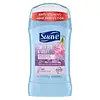What's inside
What's inside
 Key Ingredients
Key Ingredients

 Benefits
Benefits

 Concerns
Concerns

 Ingredients Side-by-side
Ingredients Side-by-side

Butane
Isobutane
Propane
Aluminum Chlorohydrate
AstringentPPG-14 Butyl Ether
Skin ConditioningCyclomethicone
EmollientParfum
MaskingQuaternium-18 Hectorite
Helianthus Annuus Seed Oil
EmollientC12-15 Alkyl Benzoate
AntimicrobialOctyldodecanol
EmollientBHT
AntioxidantDimethiconol
EmollientAlpha-Isomethyl Ionone
PerfumingBenzyl Alcohol
PerfumingBenzyl Salicylate
PerfumingButylphenyl Methylpropional
PerfumingCinnamyl Alcohol
PerfumingCitronellol
PerfumingCoumarin
PerfumingGeraniol
PerfumingHexyl Cinnamal
PerfumingHydroxycitronellal
PerfumingHydroxyisohexyl 3-Cyclohexene Carboxaldehyde
MaskingLimonene
PerfumingLinalool
PerfumingButane, Isobutane, Propane, Aluminum Chlorohydrate, PPG-14 Butyl Ether, Cyclomethicone, Parfum, Quaternium-18 Hectorite, Helianthus Annuus Seed Oil, C12-15 Alkyl Benzoate, Octyldodecanol, BHT, Dimethiconol, Alpha-Isomethyl Ionone, Benzyl Alcohol, Benzyl Salicylate, Butylphenyl Methylpropional, Cinnamyl Alcohol, Citronellol, Coumarin, Geraniol, Hexyl Cinnamal, Hydroxycitronellal, Hydroxyisohexyl 3-Cyclohexene Carboxaldehyde, Limonene, Linalool
 Reviews
Reviews

Ingredients Explained
These ingredients are found in both products.
Ingredients higher up in an ingredient list are typically present in a larger amount.
BHT is a synthetic antioxidant and preservative.
As an antioxidant, it helps your body fight off free-radicals. Free-radicals are molecules that may damage your skin cells.
As a preservative, it is used to stabilize products and prevent them from degrading. Specifically, BHT prevents degradation from oxidation.
The concerns related to BHT come from oral studies; this ingredient is currently allowed for use by both the FDA and EU.
However, it was recently restricted for use in the UK as of April 2024.
Learn more about BHTParfum is a catch-all term for an ingredient or more that is used to give a scent to products.
Also called "fragrance", this ingredient can be a blend of hundreds of chemicals or plant oils. This means every product with "fragrance" or "parfum" in the ingredients list is a different mixture.
For instance, Habanolide is a proprietary trade name for a specific aroma chemical. When used as a fragrance ingredient in cosmetics, most aroma chemicals fall under the broad labeling category of “FRAGRANCE” or “PARFUM” according to EU and US regulations.
The term 'parfum' or 'fragrance' is not regulated in many countries. In many cases, it is up to the brand to define this term.
For instance, many brands choose to label themselves as "fragrance-free" because they are not using synthetic fragrances. However, their products may still contain ingredients such as essential oils that are considered a fragrance by INCI standards.
One example is Calendula flower extract. Calendula is an essential oil that still imparts a scent or 'fragrance'.
Depending on the blend, the ingredients in the mixture can cause allergies and sensitivities on the skin. Some ingredients that are known EU allergens include linalool and citronellol.
Parfum can also be used to mask or cover an unpleasant scent.
The bottom line is: not all fragrances/parfum/ingredients are created equally. If you are worried about fragrances, we recommend taking a closer look at an ingredient. And of course, we always recommend speaking with a professional.
Learn more about ParfumWe don't have a description for PPG-14 Butyl Ether yet.